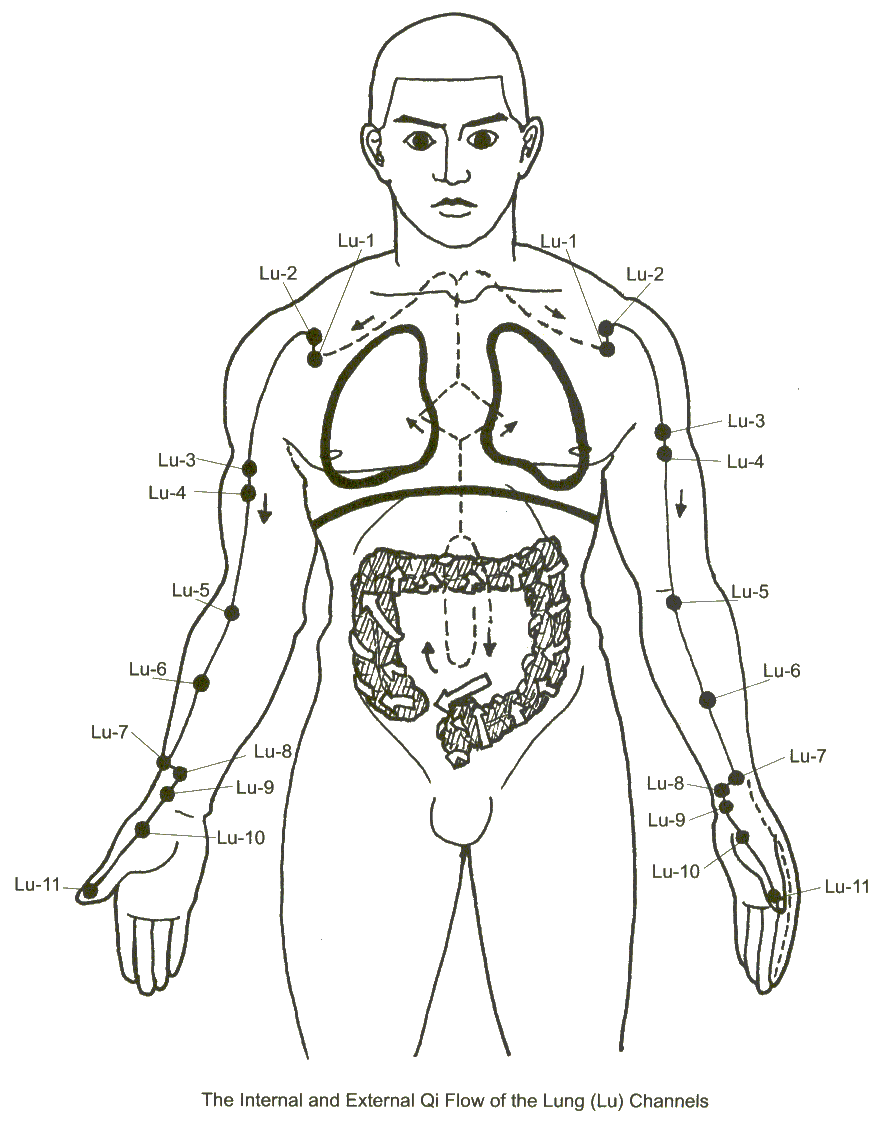
Lung: Metal-energy yin organ
Lung:
Metal-energy yin organ
Known as the 'Prime Minister', the lungs control breath and energy and assist the 'King' heart with the circulation of blood. The Internal Medicine Classic states: 'Energy is the commander of blood; when energy moves, blood follows. Blood is the mother of energy; where blood goes, energy follows.' This intimate relationship between breath and pulse, blood and energy, is the basis of Chinese breathing exercises.
Breathing controls cellular respiration, and shallow irregular breathing is therefore a major cause of low vitality and insufficient metabolism. The lungs also control the skin, which 'breathes' via the opening and closing of pores and is responsible for adjusting body temperature through perspiration and shivering. The skin is where the radiant energy of resistance emanates, forming the first line of defense against noxious environmental energies such as heat and cold. Flu and the common cold are caused by impairment of radiant skin energy's capacity to resist external invasion, and symptoms of these diseases usually settle in the lungs and bronchial tract. Pallid skin and poor complexion are common indications of weak lungs. The nose is the external aperture of the lungs and the gate of breath. A clogged or runny nose is another indicator of ailing lungs.
Breathing directly controls the autonomous nervous system, and this relationship is the basis for almost every system of yoga and meditation. By regulating the autonomous nervous system and governing energy and pulse, breathing forms a direct bridge between body and mind and may be utilized to keep the two in balance.
|
Lung |
|
| Paired Organ | Large Intestine |
| Color | pure white |
| Peak Hours | 3am-5am |
| Physical Branches | nose, skin, body hair, mucus |
| Functions | accepts pure fluids from spleen, which are then mixed with air, and circulated through the meridians, circulates Wei Qi |
Looking at the branches of a tree it can be seen that each larger branch splits in two. Each smaller branch then splits in two, and so and so on until the branches become leaves. Each leaf, then, begins with a single vein, then splits, by two, into smaller and smaller veins, until they reach the individual cells are exposed to the air. This is the same way the lungs are formed. Even more interesting is the relationship between trees and humans. Plants breathe in CO2 and breathe out O2, while humans and animals breathe in O2 and breathe out CO2. Thus trees can be considered, the lungs of the earth.

Lungs: Psycho-Emotional Aspects
It is said that the Lungs are "the priest" or The Minister of Heaven and are responsible for establishing the foundation of Qi for the entire body. The Lungs house the body's Seven Corporeal Souls (Po) and are responsible for self-protection and self-preservation. The Lungs positive psycho-emotional attributes are righteousness, dignity, integrity, and high self-esteem; their negative attributes are disappointment, sadness, grief, despair, anxiety, shame, and sorrow.
The Lung Channel Pathway, Acupuncture Points, and Internal Trajectories
The lung channel begins deep in the solar plexus region (middle burner) and descends to meet the large intestine. Winding up past the stomach, it crosses the diaphragm, divides, and enters the lungs. It then re-unites, passes up the middle of the windpipe to the throat and divides again, surfacing in the hollow region near the front of the shoulder (LU-1). From here it passes over the shoulder and down the anterior (front) aspect of the arm along the outer border of the biceps muscle. It reaches the outside of the biceps tendon in the elbow crease (LU-5), and continues down the forearm to the wrist just above the base of the thumb (LU-9). The channel crosses the height of the thumb muscle to finish at the corner of the thumbnail.

Internal Trajectories of the Lung Meridian
The Ling Shu describes the internal trajectories of the lung meridian thus:
The vessel of the lungs, hand tai yin, starts at the middle warmer. It comes down and then spirally wraps the large intestine. It then returns to and circles the entrance of the stomach, coming up, and permeates the lungs, then going to and coming out at the sides.